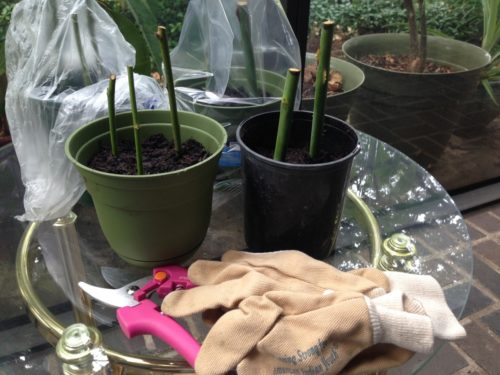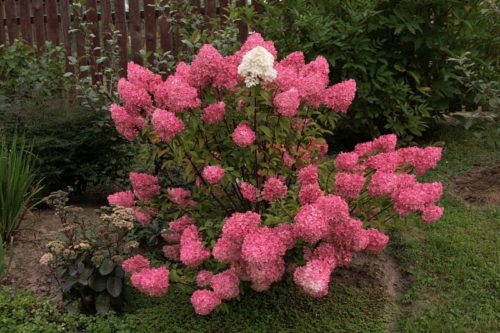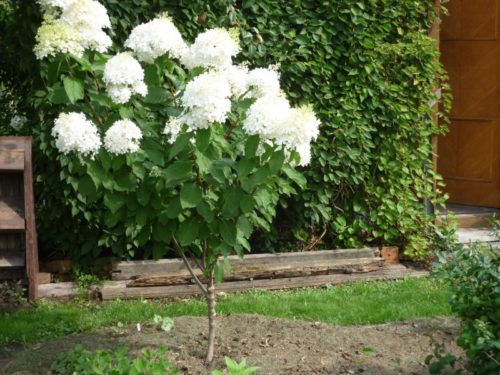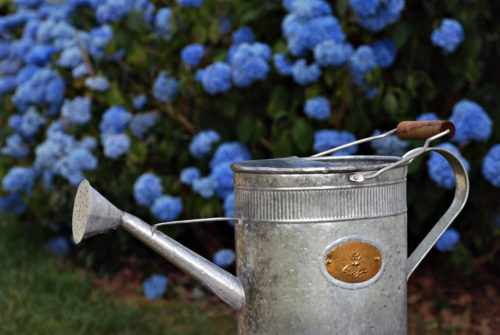Hydrangea Miscellaneous grades Phantom is one of the most unmatched flowering shrubs that are used for landscape design. A distinctive feature of this variety is considered a unique magnificent flowering and a drinking honey aroma, which comes from flowers. It is this variety that takes the greatest popularity of flower water. But not everyone knows how to properly care for such a plant and keep the flowering period for a long time. By purchasing a hydrangea of \u200b\u200bthe Phantom varieties, it is necessary to know the rules of landing and care, which will be discussed in our article.
Phantom Miscellaneous Hydrangea
Initially, the bushes of the buggy hydrangea told in Japan, Korea, China and the wildlife of Sakhalin Island. Plant selection began with the mid-18th century. Due to the place of origin, the alignment of hydrangea varieties exhibit excellent frost resistance, even in dry winter. Here the breeders tried to fame and preserved the qualities that allow the plant to grow for a long time without changing the place.
Hydrangea Miscellaneous Grade Phantom absorbed the most favorable qualities inherent in Hydrangea Paniculata maternal plant and owns advantages that they have already made it simply indispensable in squares, parks and gardens, which are unfavorable for many plants climatic conditions or having heavy soil.
The most valuable in the shrubs of the buggy hydrangea were recognized as such qualities:
- High resistance to root system diseases, such as rotting and fungal diseases, which is particularly relevant on the marshy soil.
- Resistance to low temperatures.
- Rapid recovery in the growing season, after crossing or frosting.
- A shrub can grow in one place quite a long time, without need in a transplant.
- The plant can be formed as a shrub or tree, which is of particular interest in creating landscaping places with landscape designers.
- Honey flowering duration for the whole season.
But despite the fact that the shrub is unpretentious, the landing place should be as highlighted as possible, but without direct sunlight throughout the daylight. The most suitable place for the blizzard hydrangea is the area near the buildings or near the trees that will serve as a shield from wind weather.
Hydrangea Panting Phantom, landing
- Planting material for hydrangea dilution of phantom, these are cuttings - grain. The seedling does not recommend landing before the onset of stable warming. The most favorable period - from April until the end of May.
- The preparation of the landing place should be advanced - 2-3 weeks before the planned landing. The right pit for disembarking should be no less than half a meter in length, and more by 10 cm in width.
- Fill the dug hole is necessary with fertile soil, pre-told it with peat.
- If the soil acidity is raised, it must be neutralized. This is done with the help of sawing wood ash (Bank 3 l per 1 m2) or sublimated gray.
- After sealing the landing soil, i.e. After the specified time, you can proceed to landing. During the landing, the root necks of the cuttings must be located at the level of the soil surface.
- Ground submission is gradually, for uniform distribution of it on the roots.
- Initial watering is needed abundant. At the time of water, it is necessary to trace so that the water does not blurry the soil located above the roots.
- With proper landing, the hydrangea bush of the grade phantom is captured in 2-3 weeks. It is possible to understand that the plant began, in the event that new leaves appeared on the hydrangea.
Hydrangea Panthanta Phantom. Care for shrub
After the seedlings were thoroughly set, it is necessary to properly carry out the plant, which consists of watering, feeding and trimming.
- Watering hydrangea needs to be produced once in 10-14 days. If the top layer of soil is dry, this is a sign that the plant is required by moisture. The first years of the life of a shrub watering is carried out in the amount of 8-10 liters of water under each bush. The process of watering can be combined with feeding organic fertilizers.
- With the arrival of spring, the hydrangea messenger requires the lord of nitrogen fertilizers. To stimulate the growth of new shoots, you can use any kinds of humidiation or green fertilizers. Twice a month, the shrub must be picked up a cowboy, which thoroughly fered or fermented herbs with the addition of potassium humate.
- During the phase of the hydrangea development phase by the Phantom, as in the photo characterized by the formation of buds, it is necessary to use mineral fertilizers for feeding, in which the increased maintenance of potassium and phosphorus.
- This type of hydrangea needs pruning every year, if this is not done, risks to acquire excessive thickening of the shrub, which will adversely affect its flowering.
- Time of circumcision occurs at the time of established cold weather, you need to remove at least three kidneys from the top of the blurred escape.
- In the spring period, preparation is carried out by sanitary cleaning of the frozen parts of the plant. It is worth reminding that pruning needs to be produced before the beginning of a healthy part of the branch.
- Old shrubs are rejuvenated by the way of trimming "under the stump."
Properly organized care for the pitched hydrangea phantom, judging by the reviews, helps the plant have long blossom and stably transfer adverse environmental factors.
Gorutniewicz Miscellaneous Phantom
The planting material for breeding the buggy hydrangea is the billets of last year's cuttings. Escapes need to be cropped during June, before their complete weeding. The cut material is placed for a couple of days in water tank, and then hesitated on both sides, leaving at least 4 kidneys. It is better to process the biostimulant for the growth of the roots, then place them in pots with prepared soil (peat-sand mixture).
A good option will be the placement of pots with cuttings in a greenhouse or simply close them with a can or existing film. Placing the pots are needed in a darkened place, hidden from the fall of sun rays.
Do not forget to moisturize the soil in pots with shoots. After a few weeks, seedlings must be rooted. But it is better to plant in August for the next year, then the root system of cuttings is quite strong for transplant.

Hydrangea Miscelred Phantom is the pride of any gardener. Good conditions for the proper development of shrubs will pay off the joyful contemplation of large candle-eye inflorescences, fragrant all summer.

















 Start a discussion ...
Start a discussion ...